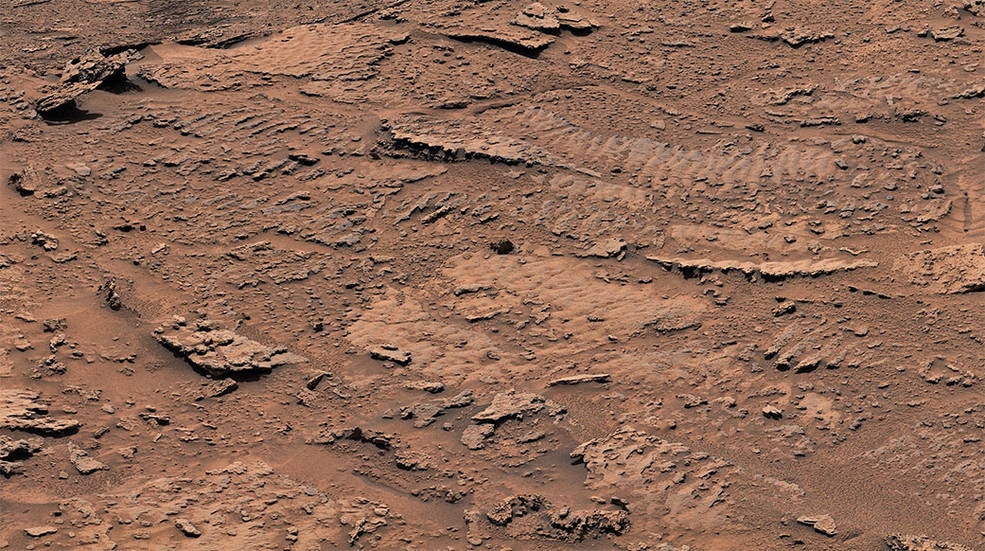
Credits: NASA/JPL-Caltech/MSSS
Among other discoveries made by the rover, rippled rock textures suggest lakes existed in a region of ancient Mars that scientists expected to be drier.
When NASA’s Curiosity rover arrived at the “sulfate-bearing unit” last fall, scientists thought they’d seen the last evidence that lakes once covered this region of Mars. That’s because the rock layers here formed in drier settings than regions explored earlier in the mission. The area’s sulfates – salty minerals – are thought to have been left behind when water was drying to a trickle.
So Curiosity’s team was surprised to discover the mission’s clearest evidence yet of ancient water ripples that formed within lakes. Billions of years ago, waves on the surface of a shallow lake stirred up sediment at the lake bottom, over time creating rippled textures left in rock.
NASA’s Curiosity rover recently found surprising clues to Mars’ watery past, including while exploring a region called the “Marker Band.”
“This is the best evidence of water and waves that we’ve seen in the entire mission,” said Ashwin Vasavada, Curiosity’s project scientist at NASA’s Jet Propulsion Laboratory in Southern California. “We climbed through thousands of feet of lake deposits and never saw evidence like this – and now we found it in a place we expected to be dry.”
Layers of History
Since 2014, the rover has been ascending the foothills of Mount Sharp, a 3-mile-tall (5-kilometer-tall) mountain that was once laced with lakes and streams that would have provided a rich environment for microbial life, if any ever formed on the Red Planet.
Billions of years ago, waves on the surface of a shallow lake stirred up sediment at the lake bottom. Over time, the sediment formed into rocks with rippled textures that are the clearest evidence of waves and water that NASA’s Curiosity Mars rover has ever found.
Mount Sharp is made up of layers, with the oldest at the bottom of the mountain and the youngest at the top. As the rover ascends, it progresses along a Martian timeline, allowing scientists to study how Mars evolved from a planet that was more Earth-like in its ancient past, with a warmer climate and plentiful water, to the freezing desert it is today.
Having climbed nearly a half-mile above the mountain’s base, Curiosity has found these rippled rock textures preserved in what’s nicknamed the “Marker Band” – a thin layer of dark rock that stands out from the rest of Mount Sharp. This rock layer is so hard that Curiosity hasn’t been able to drill a sample from it despite several attempts. It’s not the first time Mars has been unwilling to share a sample: Lower down the mountain, on “Vera Rubin Ridge,” Curiosity had to try three times before finding a spot soft enough to drill.
Scientists will be looking for softer rock in the week ahead. But even if they never get a sample from this unusual strip of rock, there are other sites they’re eager to explore.
Martian Clues
At the bottom of this valley, called Gediz Vallis, is a mound of boulders and debris that are believed to have been swept there by wet landslides billions of years ago. The rover team hopes to get a closer look at this evidence for flowing water, which is likely the youngest Curiosity will ever find.
Martian Clues
Far ahead of the Marker Band, scientists can see another clue to the history of Mars’ ancient water in a valley named Gediz Vallis. Wind carved the valley, but a channel running through it that starts higher up on Mount Sharp is thought to have been eroded by a small river. Scientists suspect wet landslides also occurred here, sending car-size boulders and debris to the bottom of the valley.
Because the resulting debris pile sits on top of all the other layers in the valley, it’s clearly one of the youngest features on Mount Sharp. Curiosity got a glimpse of this debris at Gediz Vallis Ridge twice last year but could only survey it from a distance. The rover team hopes to have another chance to view it later this year.
One more clue within the Marker Band that has fascinated the team is an unusual rock texture likely caused by some sort of regular cycle in the weather or climate, such as dust storms. Not far from the rippled textures are rocks made of layers that are regular in their spacing and thickness. This kind of rhythmic pattern in rock layers on Earth often stems from atmospheric events happening at periodic intervals. It’s possible the rhythmic patterns in these Martian rocks resulted from similar events, hinting at changes in the Red Planet’s ancient climate.
“The wave ripples, debris flows, and rhythmic layers all tell us that the story of wet-to-dry on Mars wasn’t simple,” Vasavada said. “Mars’ ancient climate had a wonderful complexity to it, much like Earth’s.”
More About the Mission
The Curiosity mission is led by NASA’s Jet Propulsion Laboratory, which is managed by Caltech in Pasadena, California. JPL leads the mission on behalf of NASA’s Science Mission Directorate in Washington. Malin Space Science Systems in San Diego built and operates Mastcam.
For more about Curiosity, visit: http://mars.nasa.gov/msl [NASA]
FUNDRAISING: KEEP STRANGESOUNDS ONLINE!… THANK YOU FOR YOUR HELP! (You will get a gemstone gift for every donation above 50$!)
You should also join my newsletter…YOU WILL LOVE IT…
I recommend following Qfiles for videos, podcasts and a wide compilation of alternative news…
The following links feature products I recommend you to add to your preparedness plan to help and protect you and your family during an emergency:
- Protect your home and car with the best lightning and EMP protection available…
- Stock up on iodine pills for the next nuclear disaster…
- Use this filter to drink clean water at home!














More NASA lies, they have never left earth, its all lies…
They make crappy movies of their lies too.
Water wave ripples that last Billions of years??? Come on. More like thousands of years ago. Notice the Blue sky? Mars has an atmosphere. Otherwise, that drone they flew about, last year could not fly. But we are not supposed to notice these things.
Maybe they filmed it on earth, and did some hollywood special effects like other nasa cornball space films?
Can’t trust anything, but I bet this is Mars. They are there, but just lie to us about everything. Like the structures there that you mentioned. There’s life there and they know it but keep telling us they have yet to discover life off planet Earth. One X Nasa scientist had a slide show at a seminar. He made no comment, but there were valleys that were green. All these liars can go into their underground bunkers, and when the PS happens, with any luck, they will be trapped in them. Good riddance.
Hmmm, we have Mars colored dirt under my snow. Lol. Green valleys and blue skies. Sounds great to me.
Re-watched video. Looks like they doctored the sky, and block-cropped/eraser tool as well as scoped video. They didn’t want people to see something. Very suspicious.
Well, they usually take normal Mars shots and make everything red. And sky darker. Plus, anything unusual they blot out.
Meh, where is the video of pyramid and sphinx? Dirt with ripples and a sissiy voice video doesn’t really make me think my tax dollars are spent very well.?☕
Sheesh, I remember in first grade (after we were proficient in cursive writing) we were told to write an essay on what we wanted to be when we were adults. About half of the boys expressed they desired to be astronauts. The girls wanted to be nurses or mothers with kids.
Now with pervert agenda, the boys would probably say they want to be girls, and the girls would say they want to be boys. Of course, Bernie “Pinko” Sanders thinks teachers all should be paid $60,000 a year. I think they should all be sent to Mars, one way— with no food or water!